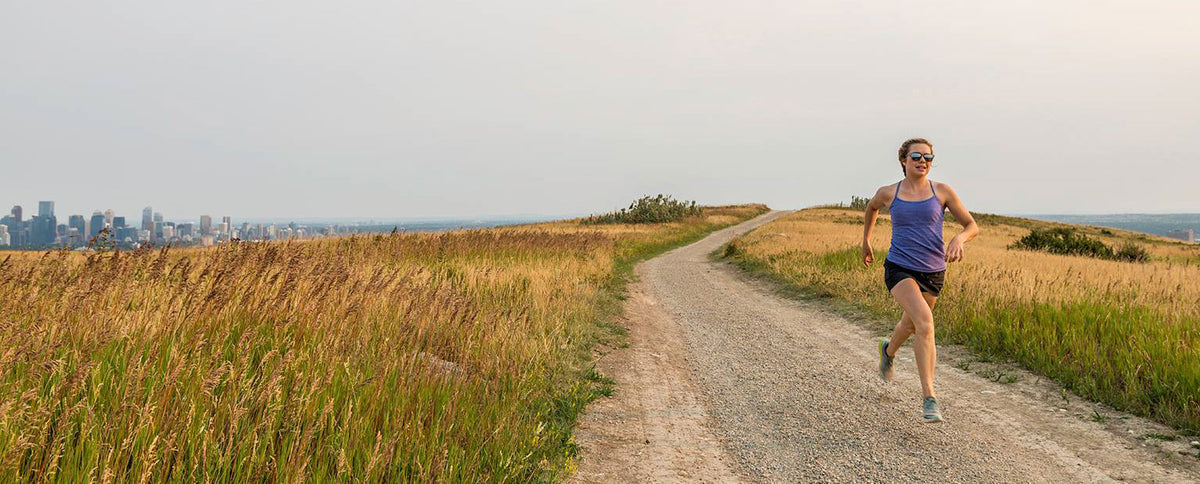Eat Like Spartan Elite and Ultra Runner Arielle Fitzgerald for a Week

Everybody wants to know how the highest-level athletes fuel their bodies for elite competition. What are their go-to foods? Which diets do they rely on for max performance? How do they strategically break up their day? In Eat Like a Champion, a recurring franchise, we give you the inside scoop on our professional athletes' dietary habits: what they're eating, why they're eating it, and when they're eating it. Follow their lead and fuel like a champion.
Imagine you're in your last year of high school — excited about your future university life and the track and field scholarship you’ve just earned. You’re going at it hard: studying, training, and competing. You’re eating the diet you’ve always eaten, trying to bolster it by snacking on granola bars all day.
Then the unthinkable begins to happen, right before your eyes: You steadily lose energy, weight, and ultimately your health. The latter collapses into severe territory. There’s even concern you could suffer a heart failure and you're prescribed bed rest.
This isn't just a narrative. Canadian ultra runner and elite Spartan racer Arielle Fitzgerald lived this story.
“One day I was at the top of my world, and the next day, I was just skin and bones,” Fitzgerald said.
She recalls the fear and frustration that ensued as her health deteriorated.
“The doctors were not giving me any answers,” Fitzgerald says. “All they would say is, ‘She has an eating disorder, she needs to eat more.’ Then they put me on antidepressants.”
Related: How Spartan Racing Helped These Athletes Recover From Eating and Body Image Disorders
A Road to Recovery Through Nutrition

She wasn’t depressed and she was eating.
“I tried explaining that everything that I ingested seemed to be going right through my system," she said. "But no one heard me.”
Growing up on a white potatoes and white rice diet, along with the granola bars, Fitzgerald’s road to recovery has earned her a keen and thorough knowledge of improved athletic performance (not to mention overall well-being) through improving digestive health. In her case, the challenge would be solving a leaky gut due to the inflammatory impact that her childhood diet had on her.
Related: 3 Immune-Boosting, Inflammation-Fighting Foods for Better Recovery
What is Leaky Gut Syndrome?
Research concerning gut health has definitely heated up over the last decade, but according to the Harvard Medical School, “Don’t be surprised if your doctor does not recognize this term.” This is Harvard’s working definition of a leaky gut:
"Inside our bellies, we have an extensive intestinal lining covering more than 4,000 square feet of surface area. When working properly, it forms a tight barrier that controls what gets absorbed into the bloodstream. An unhealthy gut lining may have large cracks or holes, allowing partially-digested food, toxins, and bugs to penetrate the tissues beneath it. This may trigger inflammation and changes in the gut flora (normal bacteria) that could lead to problems within the digestive tract and beyond."
Gut Health Through the Paleo Diet
In Fitzgerald’s case, recovering gut health — a subject she scoured Robb Wolf’s nutrition podcast to learn about — consisted of trading in most of the processed foods she was used to eating for Paleolithic-style whole foods. In fact, Wolf shared a childhood similar to Fitzgerald’s. He, too, ate a diet high in processed foods and suffered a spectrum of health issues as a result. A "Paleo diet" (otherwise known as the cavemen or stone-age diet) is characterized by eating foods more compatible with what our ancestors ate 10,000 years ago during the Paleolithic era.
The basic idea is that while modern foods have drastically changed through the
agricultural and industrial revolutions, our genetics haven’t exactly kept up.
What Is a Paleo Diet?

Eating a Paleolithic diet generally consists of choosing unprocessed fruit,
vegetables, meats, fish, nuts, and seeds as the foundation of your diet, rather
than the processed foods (imagine a loaf of white bread) that modern
supermarkets stock their shelves with.
Over time, by eating “more vegetables than a vegetarian eats,” as
she jokes, Fitzgerald was able to restore the weight, energy, and health that had
once abandoned her.
Related: Ketogenic, Paleo, Fasting: Which High-Performance Diet Is Right for You?
She has also restored her athletic performance as an elite Spartan racer
and accomplished Ultra-runner status (including world records on the treadmill for
the 50K and 100K distances).
“My diet now is Paleo with extra carbs when I need them,” Fitzgerald said,
adding that she has made nutrition foundational to her life and athletics.
Her diet looks pretty similar day-to-day, based on these three key principles she
likes to apply:
1. Protein Is the Focal Point
Fitzgerald's drumbeat is a focus on adequate protein, and she builds the remainder of her meals with nutrient-dense carbs, healthy fats, and additional carbs as necessary to top off her fuel tank.
2. Lower in Carbs, Higher in Fat
“I tend to eat lower-carbohydrate, higher-fat foods, just due to being gluten intolerant and the fact that I like fattier foods,” Fitzgerald said.
3. Prioritize Foods With High Nutrient Density
When choosing foods to fill her plate with, nutrient density is key. Nutrient-dense root vegetables, for example, are her priority when it comes to carbohydrates. Keeping an eye on nutrient density was turnkey in changing over from the low-nutrient diet that caused her downward health spiral in high school.
But overall, Fitzgerald's primary advice to fellow Spartans when it comes to diet is to focus on protein.
“Start paying attention to how much protein you are eating,” she said. “Often this is the biggest opportunity for improvement. Once you get your protein taken care of, start looking at upgrading your carbs and fats.”
With these rules in mind, this is how Fitzgerald’s diet looks on an average training day.
Meal-by-Meal Training Days

First Thing's First: Canadian Coffee With Collagen
Coffee, collagen, and maple syrup. On the addition of maple syrup, Fitzgerald commented, “Yup, I am Canadian!” Supplementing with collagen has been shown to support ligament and tendon health and elasticity, in turn helping to prevent overuse injuries like tendonitis.
Breakfast: Protein and Veggies
Fitzgerald anchors her breakfast around protein: three eggs, complemented
by an assortment of veggies.
Lunch: Eating the Rainbow
Lunch is usually a salad with chicken, walnuts, and an apple — all examples
of nutrient-dense foods. To Fitzgerald, "eating the rainbow" is a straightforward way of getting a wide range of antioxidants and phytonutrients in the diet.
“I start with something green and add colors, protein [the chicken and walnuts], and then add some olive oil and vinegar [along with the walnuts supplying healthy fats],” she said.
Her favorite additions include romaine lettuce, shredded carrots, beets, ginger, chicken, and pumpkin seeds for texture.
Afternoon Snack: Green Smoothie
Fitzgerald’s smoothie is yet another example of nutrient density. Ingredients include kale or spinach, collagen protein powder, unsweetened almond or coconut milk, strawberries, or mixed berries.
Related: 5 Protein Shake Recipes You'll Actually Want to Drink
Dinner: Primary Paleo With a Bolt of Extra Carbs
A typical dinner for Fitzgerald is salmon, rice, and veggies, but she cycles through different protein choices for dinner.
"This includes whitefish, chicken thighs, grass-fed beef, and ground turkey," she said. "I digest animal proteins better than plant proteins — this is a reason I gravitated toward a Paleo diet."
Root vegetables, Fitzgerald explained, are her priority when it comes to
carbohydrates. But to compensate for the amount of energy she burns as
an athlete, she adds white rice.

"White rice is my go-to for additional carbs, especially since I often lift
weights before dinner," she said. "My other favorite grain is buckwheat. But root
veggies are my top pick for carbs before grains."
Dark Chocolate for a Sweet Snack
Research indicates that flavonoid-rich dark chocolate is anti-inflammatory
and can boost heart health.
“I am a huge fan of dark chocolate," Fitzgerald said. "I can't stand milk chocolate, so I am definitely a bittersweet kind of person."
Related: 4 Healthy and Easy Paleo Desserts
Fitzgerald especially loves dark chocolate with peanut butter, and is perfectly content with having this treat every day.She also likes homemade energy bites. Here’s her recipe:
Arielle Fitzgerald’s Homemade Energy Bites
- 10 figs
- 1/4-1/2 cup of dark chocolate chips
- 1 cup of unsweetened coconut
- 1/4 cup of ground flaxseed or chia
- 2 tablespoons of cocoa powder
- 2 scoops of collagen protein
- 1 cup of almond butter (or peanut butter)
- 2-4 tablespoons of maple syrup (or honey)
- Pinch of salt
Blend in a high-speed blender until paste forms, and roll into balls. Keep them in the freezer or fridge for max freshness!
